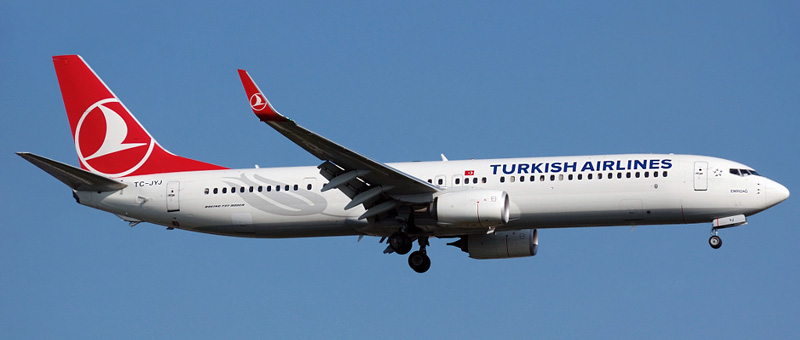
Seat map Boeing 737-900 Turkish Airlines. Best seats in the plane
Turkish Airlines operates 2 versions of Boeing 737-900.
First cabin version of the Boeing 737-900ER (739) V1
First version of Boeing 737-900ER is the most common in among two versions operated by Turkish Airlines.
This airplane may transport 151 passengers: 16 in business class and 135 in economy class.
Business class seats are located in first 4 rows and have 2-2 configuration. The seats of the 1st row have limited legroom, have no floor storage during take-off and landing and are a little narrower than standard as the tray tables are in the armrests making them immovable.
The only disadvantage of the seats of the 4th row is location of more crowded economy class behind.
Economy class seats are located in 23 rows: 22 of them have 3-3 configuration and the last row contains 3 seats.
Because of the position of the bulkhead the seats of the 5th row have less space for passengers’ legs. For passengers traveling with babies these seats offer bassinet locations.
Missing window is the main disadvantage of the seat 9A.
Due to the exit row located behind the seats of the 10th row are not reclining.
Passengers of the seats of the 11th row will take advantage of extra legroom. However, these seats do not recline, are narrower than standard and have no floor storage during take-off and landing.
The best seats of the economy class are considered the seats of the 12th row. These seats offer additional space for passengers’ legs. But these seats are a little narrower than standard and have no floor storage during take-off and landing.
Location of the galley and lavatories behind will cause inconvenience to passengers of the seats 27ABC, 27D and 27DEF. Because of the curvature of the airplane the seats 27ABC and 27DEF are a little narrower and less reclining than standard.
Second cabin version of the Boeing 737-900ER (739) V2
Second version of Boeing 737-900 offers 169 seats in two classes.
Business class consists of 16 recliner seats. All these seats are standard, only the seats of the 1st row have limited space for passengers’ legs due to position of the bulkhead. Among other disadvantages: location of the galley and lavatory in front, lack of floor storage during take-off and landing and slightly reduced width.
Economy class consists of 153 seats. The major part of the seats have 3-3 configuration.
Because of position of the bulkhead the seats of the 5th row have less space for passengers’ legs. Also, these seats have no floor storage during take-off and landing and are narrower than standard because the tray tables are built-in the armrests making them immovable.
Due to location of the exit row behind the seats of the 12th row have limited legroom.
As the seats of the 13th row are located between two exit rows, they have extra legroom but also are less reclining and have no floor storage during take-off and landing.
Passengers of the seats of the 14th row will take advantage of extra space for their legs. The only disadvantage is lack of floor storage during take-off and landing.
The noise from the galleys and lavatories located behind will cause discomfort to passengers of the seats 29ABC, 29D and 30DEF. In addition the seats 29ABC and 30DEF have limited recline that is why these seats are considered bad seats.
Useful information about “Turkish Airlines”
- Rating and reviews about “Turkish Airlines”
- Boeing 737-900 Turkish Airlines. Photos and description of the plane
- Turkish Airlines – company description and aircrafts fleet


